Xingchen Liu
Channel Knowledge Maps for 6G Wireless Networks: Construction, Applications, and Future Challenges
May 30, 2025Abstract:The advent of 6G wireless networks promises unprecedented connectivity, supporting ultra-high data rates, low latency, and massive device connectivity. However, these ambitious goals introduce significant challenges, particularly in channel estimation due to complex and dynamic propagation environments. This paper explores the concept of channel knowledge maps (CKMs) as a solution to these challenges. CKMs enable environment-aware communications by providing location-specific channel information, reducing reliance on real-time pilot measurements. We categorize CKM construction techniques into measurement-based, model-based, and hybrid methods, and examine their key applications in integrated sensing and communication systems, beamforming, trajectory optimization of unmanned aerial vehicles, base station placement, and resource allocation. Furthermore, we discuss open challenges and propose future research directions to enhance the robustness, accuracy, and scalability of CKM-based systems in the evolving 6G landscape.
TASTE-Rob: Advancing Video Generation of Task-Oriented Hand-Object Interaction for Generalizable Robotic Manipulation
Mar 14, 2025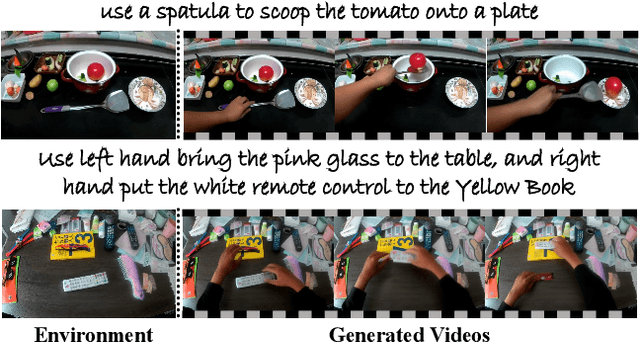

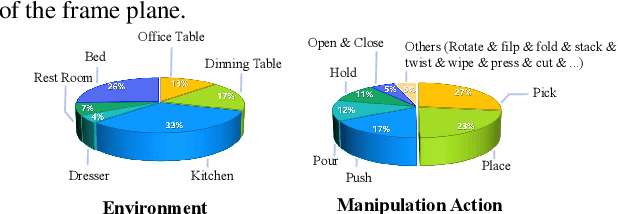
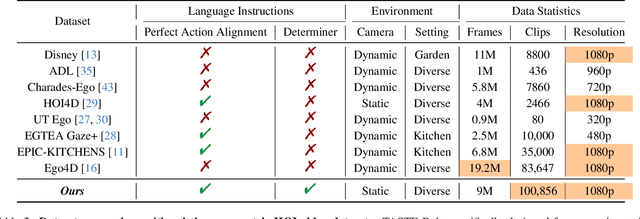
Abstract:We address key limitations in existing datasets and models for task-oriented hand-object interaction video generation, a critical approach of generating video demonstrations for robotic imitation learning. Current datasets, such as Ego4D, often suffer from inconsistent view perspectives and misaligned interactions, leading to reduced video quality and limiting their applicability for precise imitation learning tasks. Towards this end, we introduce TASTE-Rob -- a pioneering large-scale dataset of 100,856 ego-centric hand-object interaction videos. Each video is meticulously aligned with language instructions and recorded from a consistent camera viewpoint to ensure interaction clarity. By fine-tuning a Video Diffusion Model (VDM) on TASTE-Rob, we achieve realistic object interactions, though we observed occasional inconsistencies in hand grasping postures. To enhance realism, we introduce a three-stage pose-refinement pipeline that improves hand posture accuracy in generated videos. Our curated dataset, coupled with the specialized pose-refinement framework, provides notable performance gains in generating high-quality, task-oriented hand-object interaction videos, resulting in achieving superior generalizable robotic manipulation. The TASTE-Rob dataset will be made publicly available upon publication to foster further advancements in the field.
UnCommon Objects in 3D
Jan 13, 2025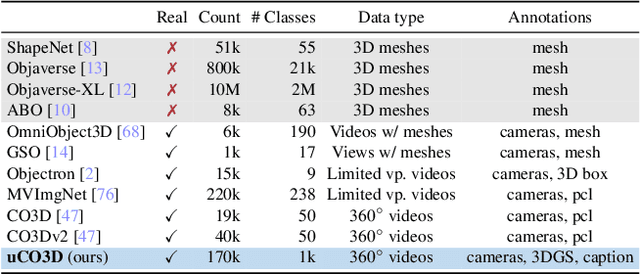


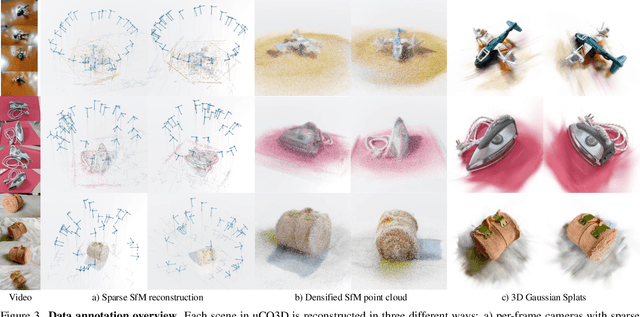
Abstract:We introduce Uncommon Objects in 3D (uCO3D), a new object-centric dataset for 3D deep learning and 3D generative AI. uCO3D is the largest publicly-available collection of high-resolution videos of objects with 3D annotations that ensures full-360$^{\circ}$ coverage. uCO3D is significantly more diverse than MVImgNet and CO3Dv2, covering more than 1,000 object categories. It is also of higher quality, due to extensive quality checks of both the collected videos and the 3D annotations. Similar to analogous datasets, uCO3D contains annotations for 3D camera poses, depth maps and sparse point clouds. In addition, each object is equipped with a caption and a 3D Gaussian Splat reconstruction. We train several large 3D models on MVImgNet, CO3Dv2, and uCO3D and obtain superior results using the latter, showing that uCO3D is better for learning applications.
Millimeter-Wave Energy-Efficient Hybrid Beamforming Architecture and Algorithm
Jan 03, 2025Abstract:This paper studies energy-efficient hybrid beamforming architectures and its algorithm design in millimeter-wave communication systems, aiming to address the challenges faced by existing hybrid beamforming due to low hardware flexibility and high power consumption. To solve the problems of existing hybrid beamforming, a novel energy-efficient hybrid beamforming architecture is proposed, where radio-frequency (RF) switch networks are introduced at the front and rear ends of the phase shifter network, enabling dynamic connections between the RF chains and the phase shifter array as well as the antenna array. The system model of the proposed architecture is established, including digital precoding and analog precoding processes, and the practical hardware limitations such as quantization errors of the digital-to-analog converter (DAC) and phase shifter resolution. In order to maximize the energy efficiency, this paper derives an energy efficiency model including spectral efficiency and system power consumption, and a hybrid precoding algorithm is proposed based on block coordinate descent to iteratively optimize the digital precoding matrix, analog precoding matrix, and DAC resolution. Simulation results under the NYUSIM-generated millimeter-wave channels show that the proposed hybrid beamforming architecture and precoding algorithm have higher energy efficiency than existing representative architectures and precoding algorithms under complete and partial channel state information, while the loss of spectral efficiency compared to fully connected architecture is less than 20%
* 21 pages, in Chinese language, 8 figures, published to Mobile Communications
Multi-scale Topology Optimization using Neural Networks
Apr 11, 2024Abstract:A long-standing challenge is designing multi-scale structures with good connectivity between cells while optimizing each cell to reach close to the theoretical performance limit. We propose a new method for direct multi-scale topology optimization using neural networks. Our approach focuses on inverse homogenization that seamlessly maintains compatibility across neighboring microstructure cells. Our approach consists of a topology neural network that optimizes the microstructure shape and distribution across the design domain as a continuous field. Each microstructure cell is optimized based on a specified elasticity tensor that also accommodates in-plane rotations. The neural network takes as input the local coordinates within a cell to represent the density distribution within a cell, as well as the global coordinates of each cell to design spatially varying microstructure cells. As such, our approach models an n-dimensional multi-scale optimization problem as a 2n-dimensional inverse homogenization problem using neural networks. During the inverse homogenization of each unit cell, we extend the boundary of each cell by scaling the input coordinates such that the boundaries of neighboring cells are combined. Inverse homogenization on the combined cell improves connectivity. We demonstrate our method through the design and optimization of graded multi-scale structures.
RLPlanner: Reinforcement Learning based Floorplanning for Chiplets with Fast Thermal Analysis
Jan 16, 2024Abstract:Chiplet-based systems have gained significant attention in recent years due to their low cost and competitive performance. As the complexity and compactness of a chiplet-based system increase, careful consideration must be given to microbump assignments, interconnect delays, and thermal limitations during the floorplanning stage. This paper introduces RLPlanner, an efficient early-stage floorplanning tool for chiplet-based systems with a novel fast thermal evaluation method. RLPlanner employs advanced reinforcement learning to jointly minimize total wirelength and temperature. To alleviate the time-consuming thermal calculations, RLPlanner incorporates the developed fast thermal evaluation method to expedite the iterations and optimizations. Comprehensive experiments demonstrate that our proposed fast thermal evaluation method achieves a mean absolute error (MAE) of 0.25 K and delivers over 120x speed-up compared to the open-source thermal solver HotSpot. When integrated with our fast thermal evaluation method, RLPlanner achieves an average improvement of 20.28\% in minimizing the target objective (a combination of wirelength and temperature), within a similar running time, compared to the classic simulated annealing method with HotSpot.
Optimization of RIS Placement for Satellite-to-Ground Coverage Enhancement
Nov 06, 2023Abstract:In satellite-to-ground communication, ensuring reliable and efficient connectivity poses significant challenges. The reconfigurable intelligent surface (RIS) offers a promising solution due to its ability to manipulate wireless propagation environments and thus enhance communication performance. In this paper, we propose a method for optimizing the placement of RISs on building facets to improve satellite-to-ground communication coverage. We model satellite-to-ground communication with RIS assistance, considering the actual positions of buildings and ground users. The theoretical lower bound on the coverage enhancement in satellite-to-ground communication through large-scale RIS deployment is derived. Then a novel optimization framework for RIS placement is formulated, and a parallel genetic algorithm is employed to solve the problem. Simulation results demonstrate the superior performance of the proposed RIS deployment strategy in enhancing satellite communication coverage probability for non-line-of-sight users. The proposed framework can be applied to various architectural distributions, such as rural areas, towns, and cities, by adjusting parameter settings.
How to Differentiate between Near Field and Far Field: Revisiting the Rayleigh Distance
Sep 23, 2023Abstract:Future wireless communication systems are likely to adopt extremely large aperture arrays and millimeter-wave/sub-THz frequency bands to achieve higher throughput, lower latency, and higher energy efficiency. Conventional wireless systems predominantly operate in the far field (FF) of the radiation source of signals. As the array size increases and the carrier wavelength shrinks, however, the near field (NF) becomes non-negligible. Since the NF and FF differ in many aspects, it is essential to distinguish their corresponding regions. In this article, we first provide a comprehensive overview of the existing NF-FF boundaries, then introduce a novel NF-FF demarcation method based on effective degrees of freedom (EDoF) of the channel. Since EDoF is intimately related to spectral efficiency, the EDoF-based border is able to characterize key channel performance more accurately, as compared with the classic Rayleigh distance. Furthermore, we analyze the main features of the EDoF-based NF-FF boundary and provide insights into wireless system design.
A sentiment analysis model for car review texts based on adversarial training and whole word mask BERT
Jun 06, 2022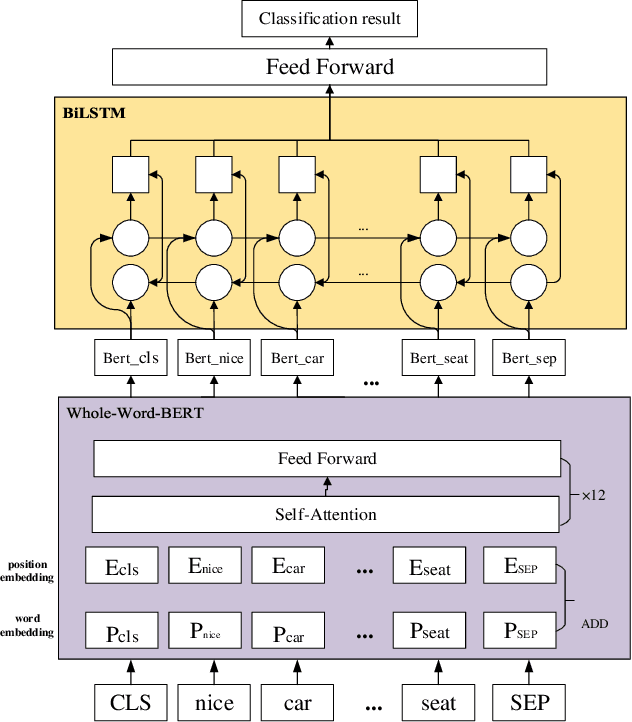
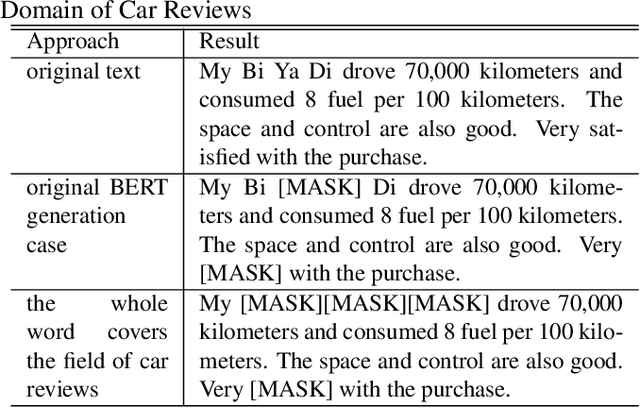
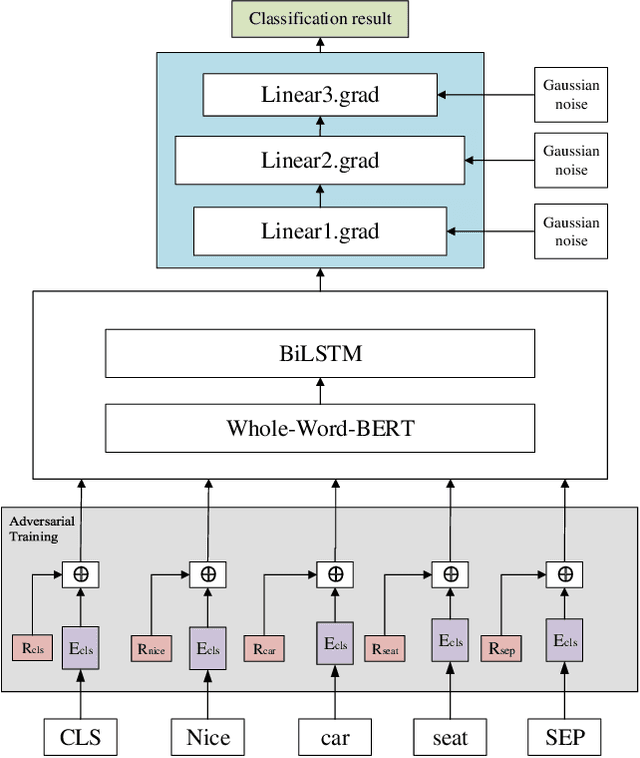

Abstract:In the field of car evaluation, more and more netizens choose to express their opinions on the Internet platform, and these comments will affect the decision-making of buyers and the trend of car word-of-mouth. As an important branch of natural language processing (NLP), sentiment analysis provides an effective research method for analyzing the sentiment types of massive car review texts. However, due to the lexical professionalism and large text noise of review texts in the automotive field, when a general sentiment analysis model is applied to car reviews, the accuracy of the model will be poor. To overcome these above challenges, we aim at the sentiment analysis task of car review texts. From the perspective of word vectors, pre-training is carried out by means of whole word mask of proprietary vocabulary in the automotive field, and then training data is carried out through the strategy of an adversarial training set. Based on this, we propose a car review text sentiment analysis model based on adversarial training and whole word mask BERT(ATWWM-BERT).
Bridging the gap between prostate radiology and pathology through machine learning
Dec 03, 2021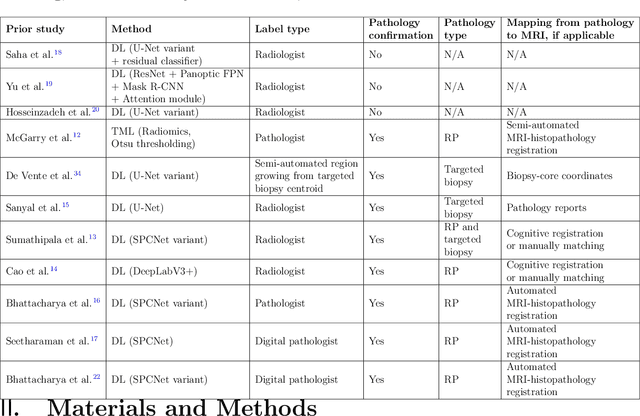
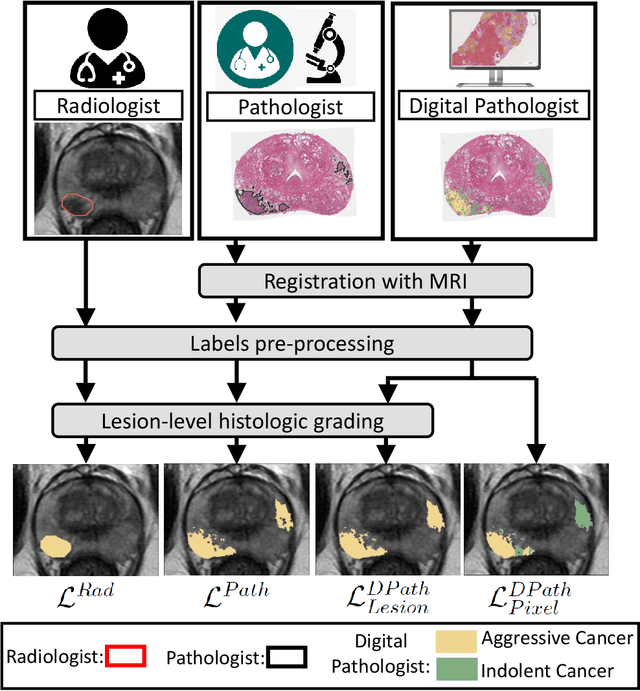
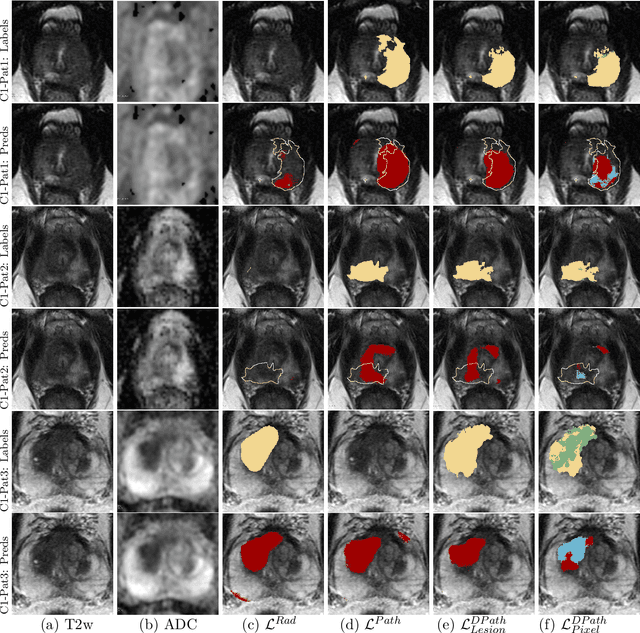
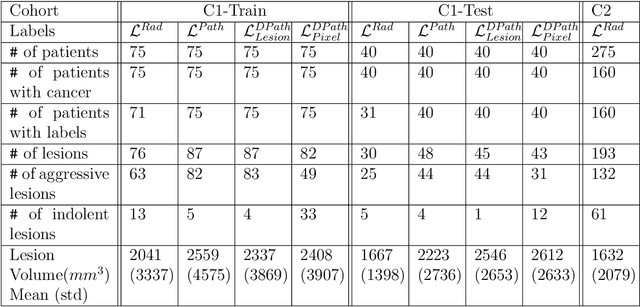
Abstract:Prostate cancer is the second deadliest cancer for American men. While Magnetic Resonance Imaging (MRI) is increasingly used to guide targeted biopsies for prostate cancer diagnosis, its utility remains limited due to high rates of false positives and false negatives as well as low inter-reader agreements. Machine learning methods to detect and localize cancer on prostate MRI can help standardize radiologist interpretations. However, existing machine learning methods vary not only in model architecture, but also in the ground truth labeling strategies used for model training. In this study, we compare different labeling strategies, namely, pathology-confirmed radiologist labels, pathologist labels on whole-mount histopathology images, and lesion-level and pixel-level digital pathologist labels (previously validated deep learning algorithm on histopathology images to predict pixel-level Gleason patterns) on whole-mount histopathology images. We analyse the effects these labels have on the performance of the trained machine learning models. Our experiments show that (1) radiologist labels and models trained with them can miss cancers, or underestimate cancer extent, (2) digital pathologist labels and models trained with them have high concordance with pathologist labels, and (3) models trained with digital pathologist labels achieve the best performance in prostate cancer detection in two different cohorts with different disease distributions, irrespective of the model architecture used. Digital pathologist labels can reduce challenges associated with human annotations, including labor, time, inter- and intra-reader variability, and can help bridge the gap between prostate radiology and pathology by enabling the training of reliable machine learning models to detect and localize prostate cancer on MRI.
 Add to Chrome
Add to Chrome Add to Firefox
Add to Firefox Add to Edge
Add to Edge